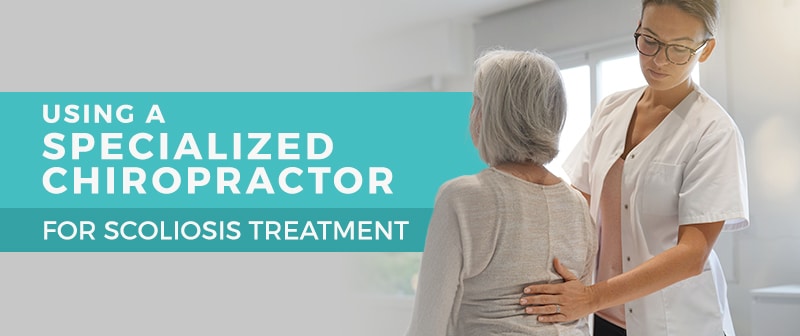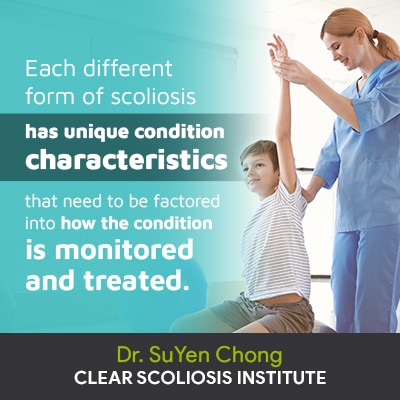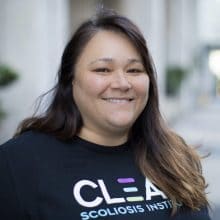
There are different treatment options for scoliosis that produce different potential outcomes, which is why it’s so important for patients and their families to research the options available to them. CLEAR-certified scoliosis chiropractors not only know the spine, but also understand how scoliosis affects it, and how best to impact the condition on a structural level.
There was a time when surgery was the main option in scoliosis treatment, but as our understanding of the condition has evolved, so too have related treatment options. Scoliosis chiropractors can work towards reducing the abnormal curvature while preserving the spine’s overall health and function.
Scoliosis is a complex condition that can range from mild to moderate to severe. In addition, there are many different types of scoliosis that can develop. What different severity levels and condition types have in common, however, is that they are progressive and need proactive treatment to be managed effectively. Let’s start exploring how chiropractors can help patients with scoliosis by discussing some important condition characteristics.
Being diagnosed with scoliosis means the spine has an abnormal sideways curvature of a certain degree along with rotation. While the spine has natural and healthy curves that give it added strength, flexibility, and enable its even distribution of mechanical stress, when one or more of these healthy curves are lost, its overall health and function is disrupted.
A patient’s Cobb angle tells us how far out of alignment a scoliotic spine is and guides the treatment plan’s design and application. An official diagnosis of structural scoliosis has to include rotation and a Cobb angle measurement of at least 10 degrees.
Cobb angle is a measurement taken via X-ray by drawing intersecting lines from the bottoms and tops of the curvature’s most-tiled vertebrae (bones of the spine). The resulting angle is measured in degrees and places the condition on its severity scale of mild, moderate, or severe.
Mild scoliosis: Cobb angle measurement of between 10 and 25 degrees
Moderate scoliosis: Cobb angle measurement of between 25 and 40 degrees
Severe scoliosis: Cobb angle measurement of 40+ degrees

‘Idiopathic’ means there is no single-known cause to account for the condition’s development, and 80 percent of known diagnosed scoliosis cases are idiopathic; the remaining 20 percent have known causes associated with them, such as neuromuscular, congenital, degenerative, and traumatic.
Each different form of scoliosis has unique condition characteristics that need to be factored into how the condition is monitored and treated.
While we don’t fully understand the ‘why’ behind the majority of scoliosis conditions developing, we most certainly understand how to effectively manage their progression and impact them on a structural level.
As scoliosis is progressive, meaning it’s in its nature to worsen over time, proactive treatment is an essential aspect of managing the condition by staying ahead of its progressive line.
Here at the CLEAR Scoliosis Institute, our team is made up of CLEAR-certified scoliosis chiropractors capable of achieving impressive treatment results that help patients live their best lives with the condition.
Now that we have talked generally about scoliosis and some of its important condition characteristics, let’s move on to the specifics of how scoliosi-specific chiropractic-centered treatment can impact the condition.
As mentioned, there are different treatment approaches to scoliosis, some more invasive than others. While the traditional approach often offers spinal-fusion surgery as the means by which a straighter spine is achieved, that outcome can come at a high price.
Different treatment approaches are guided by their end goals, which is why the traditional approach of spinal fusion surgery can fall short when it comes to preserving the spine’s optimal health and function.
Many people wonder if chiropractic is even safe for people with scoliosis, and while general chiropractic can’t deliver the same long-term treatment results as scoliosis-specific chiropractic care, it can be a safe and effective means of providing patients with short-term pain relief for adults; however, in order for chiropractic care to impact the condition on a structural level, chiropractic care has to be scoliosis-specific.
In fact, a study monitoring the potential of using a chiropractic rehabilitation program to treat adult scoliosis showed that improvements in Cobb angle, pain scores, lung capacity, and disability rating were indeed possible.
When it comes to the scoliosis-specific chiropractic-centered approach we offer here at CLEAR, the goal of treatment is not solely to stop progression, but to, first and foremost, address the underlying structural nature of the condition to achieve corrective results.
In addition, CLEAR scoliosis chiropractors take 77 different measurements via X-ray to assess a condition, which is much more than the traditional general chiropractor or medical doctor is looking at.
In doing so, we can work towards managing a patient’s progression by reducing their curvature through a combination of precise chiropractic adjustments and specialized equipment and scoliosis-specific exercises and therapies.
Related: Non-Surgical Scoliosis Treatment Options
So what exactly does our treatment approach here at CLEAR involve?
Treatment Sessions with a CLEAR-Certified Scoliosis Chiropractor

While treatment addresses condition severity by working towards reducing a patient’s Cobb angle, we also want to address any additional scoliosis-related symptoms a patient is experiencing.
The first stage of our treatment sessions involves readying the body for the treatment process. This is achieved through a combination of scoliosis-specific warm-up exercises, massage, and other disciplines designed to keep the spine and its surrounding soft tissue as loose and flexible as possible; this can make the spine more responsive to the next phase of treatment.
The next phase involves specialized scoliosis-specific chiropractic adjustments delivered via mechanical adjusting instruments that provide gentle and precise correction.
While we focus on the spine’s most-affected area, we treat the whole spine, plus any other areas of the body experiencing related stress from the abnormal curvature, such as the hips.
The final stage of our treatment sessions focuses on sustaining corrective results by influencing posture, balance, and coordination; this is accomplished through the introduction of customized scoliosis-specific exercises per individual that can activate certain muscle groups located close to the spine that help provide it with support and stabilization.
As we know that the brain and spine work together to form the body’s central nervous system (CNS), we also utilize exercises that can stimulate certain areas of the brain to enhance the brain-body connection for more balanced and natural body-positioning.
Through customized treatment plans that feature scoliosis-specific therapies, chiropractic adjustments, and exercises, we work toward reducing a spine’s abnormal curvature, strengthening its surrounding muscles, and sustaining those results through rehabilitation.
As these treatment goals address key aspects of the condition’s progressive and structural nature, the spine’s overall strength, flexibility, and function are preserved as corrective results are achieved.
The spine is a complex and important part of human anatomy. It enables us to stand upright, balance, engage in flexible movement, and provides the body with structure. It also works with the brain to form the central nervous system and facilitate communication between the brain and the rest of the body.
When a spinal condition like scoliosis disrupts the spine’s biomechanics, its overall health and function is adversely affected and can cause numerous effects throughout the body; this is why it’s important to address any and all scoliosis-related symptoms by treating the whole patient, and not just the most-affected area of the spine.
While there are different treatment options available, they are mainly governed by their end goals. A treatment approach that comes at the cost of the spine’s function and health oftentimes results in lower quality of life moving forward.
Here at the CLEAR Scoliosis Institute, we deliver corrective results through customizing treatment plans that include a combination of scoliosis-specific chiropractic care, exercises, and therapies.
Ultimately, I encourage patients, and their families, to fully research all the scoliosis treatment options available to them. By doing this, they are ensuring that their treatment expectations are realistic and will offer them the best possible quality of life moving forward.
The complexities of scoliosis necessitate an integrative and specific treatment approach, and while general chiropractic is capable of providing patients with short-term pain relief, impacting the condition on a structural level for long-term results is beyond its scope.
Scoliosis-specific chiropractors, however, can help patients by crafting a treatment plan that prioritizes the spine’s overall health and function, while working towards impacting the condition’s underlying structural nature.
Clear-institute.org - Cobb Angle
Clear-institute.org - The CLEAR Approach
Clear-institute.org - CLEAR Certified Scoliosis Chiroprators

CLEAR provides a unique and innovative way of understanding scoliosis. Sign up to receive facts and information you won’t find anywhere else.

Greetings!
Thanks for sharing your story, Nice blog.